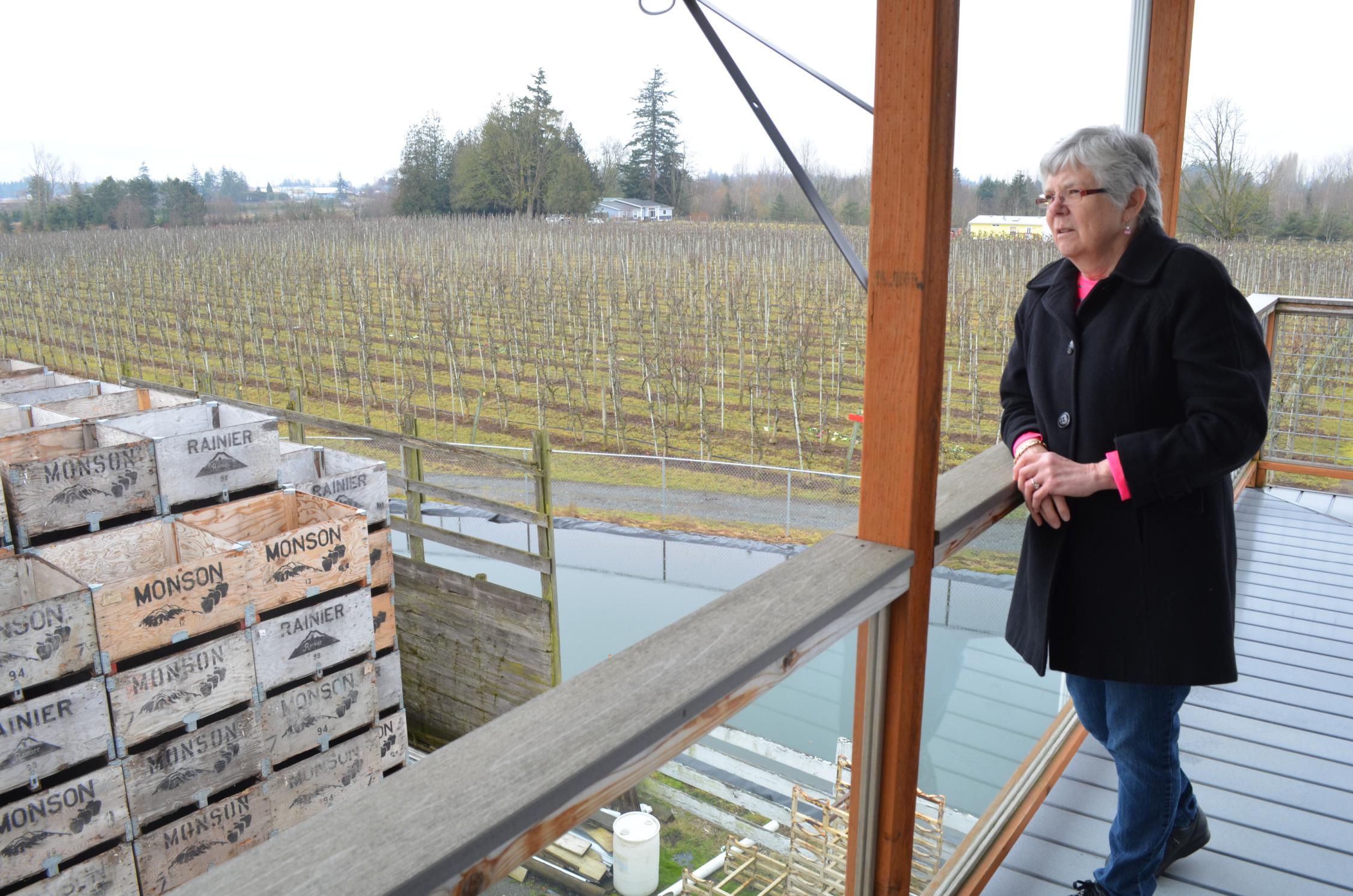
Dorie Belisle is co-owner of Bellewood Acres in Whatcom County. It is Western Washington's largest apple orchard.
Eilís O'Neill, KUOW / EarthFix
From the BelleWood Acres farmhouse in Washington's Whatcom County, you can see piles of apple crates and rows of trees that stretch for acres. This is the biggest apple orchard west of the Cascades.
“Spring time’s magical in the orchard,” says John Belisle, who owns the orchard with his wife, Dorie.
“There’s bees everywhere,” Dorie agrees. “The orchards hum with their working.”
But springtime in Western Washington’s wet weather also brings something a lot less magical than bees and blossoms. It brings fungi — like apple scab and anthracnose. That means, for fruit growers in the Pacific Northwest, it’s time for the annual struggle between keeping their trees alive and keeping conditions safe for the bees that pollinate those trees.
In the 1990s, Western Washington apple farmers nearly lost the battle to anthracnose.
Anthracnose “puts wounds on the trees, you might say, and takes away the circulation in the cambium, kills the tree,” John Belisle explains. “It likes moisture. So the other side of the mountains do not have that problem. It’s just kind of us. You keep cutting it out, but eventually, the tree disappears.”
In the late 1990s, while apples were booming east of the Cascades, Western Washington lost hundreds of acres, 17 percent of its total apple acreage. Some counties lost all their apple trees.

The farmers who survived, like the Belisles, had found a tool for fighting back: fungicides.
“You can put fungicides on the trees that are there like birth control,” John Belisle explains. “Every week, we go out and put a fungicide on and it stays there and then when the rains come and the pathogens are released from the leaves they go up into the tree and land on a product that’s protected and they can’t reproduce.”
But the fungicides that saved the trees could now be threatening the orchards.
“It turns out that honeybees that ingest fungicides have trouble breaking down the phytochemicals in their natural food,” says May Berenbaum, a bee researcher at the University of Illinois Urbana-Champaign. “So not only are the chemicals themselves potentially toxic, but they can interfere with the ability of honeybees to extract the energy they need from the food they eat.”
The problem is that regulations don’t always reflect everything scientists have learned about bees. Historically, the Environmental Protection Agency has only tested whether or not a chemical kills adult bees outright and hasn’t looked at how chemicals might weaken bees or affect larval bees.
So, a few years ago, the EPA revisited how it reviews pesticides. “Their new risk assessment process includes both acute and chronic effects,” says Erik Johansen, with the Washington State Department of Agriculture. “It also looks at effects not just on adult bees, but also on larval bees, on bees as they’re developing. So any new active ingredients would go through that process.”
But it takes awhile to get back to all the chemicals that have already been approved.

Dorie and John Belisle at their BelleWood Acres apple orchard, which also operates a distillery.
Eilís O'Neill, KUOW / EarthFix
“Every fifteen years, give or take, they’re going to relook at all existing active ingredients,” Johansen says.
It’s not that farmers are doing anything wrong. John Belisle, with BelleWood Acres, says they’re just following the label.
“The way we know whether it’s toxic or not – the way we think we know- — is that the label says you can spray it on bees or the label says you can’t,” he says. “The label might even say spray at night. If there’s [sic] bees in the orchard, spray at night.”
But, given the rate of change with EPA pesticide labeling, it could be another decade and a half before the government's instructions on farm chemicals reflect the latest science.
